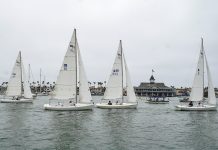Ahoy!
Sad, very sad, that the Newport-to-Ensenada race had fatalities on the course. I do not have enough information and details for this week’s column, however next week I will let you know what happened. To me and other experienced ocean-going boaters, it looks like a collision with a ship, but there is also some evidence that it may have hit North Coronado Island. I will find out and report to you.
***
So, you are cruising with you family to Avalon on Santa Catalina Island on a picture-perfect Friday evening, and half way across the channel you notice a dozen or so people waving frantically from a 20-plus-foot drifting open boat with a single outboard on the transom. You first inclination is to see what is the matter with the boat and render assistance to the stranded people. However, this small boat looks out of place on the open seas, and you remember reading about the numerous pangas coming up from Mexico smuggling either drugs or people, or both.
So, what do you do?
There has been an influx of pangas landing on beaches are far up as Santa Barbara as the smugglers are punching further north in search are remote beaches near highways. Palos Verdes Peninsula has been a hot spot for abandoned boats, and last August, three men who tried to smuggle drugs north of border were arrested about a mile off the Newport Pier.
Mostly cruising at night, the smugglers will steer the small boats miles offshore to prevent being detected by San Diego’s radar and other boaters. This is a very risky maneuver in the outer waters, as these boats are not meant to travel in open seas, cruising uphill into the swells and wind. The boats may or may not have lifejackets, food, and water for the trip, and they typically carry extra gasoline to make the long voyage. Of course, the fuel cans are discarded into the ocean when empty.
The Channel Islands are not immune, either. Smugglers have been caught on Catalina Island, Santa Rosa Island, and Santa Cruz Island. Sometimes, the skipper, if you can call the smuggler a skipper, will drop off the passengers in the surf line, and then turn the boat back to Mexico to pick up another group. However, sometimes the cargo is more valuable than the panga, and abandoned boats have been found on beaches at morning sunrise.
These illegal boats pose a threat to the unsuspecting recreational or good Samaritan boater who may cross paths with the smugglers. Keep in mind that the boats are traveling under the cover of darkness without any navigational lights, and a fiberglass panga will reflect a small radar signature, if any at all. So, it would be easy to collide with a panga at night, but I am sure the panga’s skipper is trying to steer clear of being seen by any vessel.
Secondly, if you stop to render aid to a disabled panga, there is nothing to stop the smugglers from seizing your boat. Therefore, what do you do to protect your family, friends, and yourself from the potentially dangerous boats transiting our waters?
Use your boating knowledge and common sense when approaching any disabled vessel at sea, and use your VHF marine radio to alert the Coast Guard. If the boat looks out of place, like a panga in the ocean, overloaded with people – or your gut tells you something is wrong with the situation – then keep your distance. Radio the Coast Guard on channel 16 to report your latitude and longitude, your vessel and the disabled vessel’s description, number of people onboard both vessels, and what you are observing.
I have had a personal experience with a disabled sailboat drifting just south of the border in Mexican waters when I was delivering a yacht from Ensenada to Marina del Rey. As I was cruising northbound for customs in San Diego, I saw a few fellows waving their arms for help. Of course, it is the duty of boaters to stop and render aid. However, I had a funny feeling about this boat as the lines were a mess, the sails were dropped on the deck, and the overall appearance of the vessel was not shipshape.
I radioed the Coast Guard in San Diego before I approached the vessel, to apprise them of my situation. After which, I would back down on the sailboat only close enough to communicate with the crew, and then I would pull away to a safe distance to relay the information to the Coast Guard. It turned out that the people aboard the sailboat where just trying to get a free tow in lieu of sailing the remainder of the distance to San Diego.
Tip of the week is to report any suspicious or out-of-the-ordinary boats or activity to the appropriate authorities. Inside Newport Harbor and up to 3 miles off the coast, you can call the Newport Harbor Patrol, and sometimes it is prudent to use your cell phone to be discreet.
And don’t forget: Tune in to the No. 1 boating radio talk show in the nation, Capt. Mike Whitehead’s Boathouse Radio Show, broadcasting coast-to-coast on the CRN Digital Talk Radio syndicated network every Saturday at noon, Pacific Time and replayed on Sunday at 10 am Pacific. Join Chandler Bell and me as we talk about “all things boating.” You can find the station listings, cable TV channels, live streaming on the Internet, and now available are apps to listen to the show for your iPhone, Blackberry, iTouch, Android, Palm, and Windows Mobile at www.BoathouseTV.com or www.BoathouseRadio.com.
Until next week, Safe Voyages!




